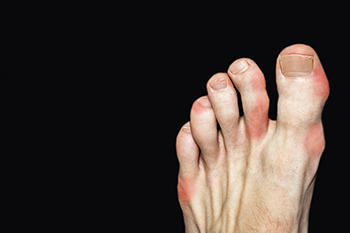 Foot pain is a common symptom for a variety of different foot conditions. The location of pain within the foot may help determine what the cause is. Heel pain is often associated with plantar fasciitis, an inflammation in the band of tissue that runs along the bottom of the foot connecting the heel bone to the toes. Stone bruises are deep bruises on the fat pad of the heel, and heel spurs are irregular bone growths on the bottom of the heel. Both conditions are also causes of foot and heel pain. Pain in the ball of the foot can be caused by conditions like metatarsalgia, Morton’s neuroma, and sesamoiditis. Pain in the arch of the foot may be caused by flat feet, but more commonly, arch pain is caused due to plantar fasciitis. Toe pain can be caused by gout, arthritis, foot deformities like hammertoes or bunions, ingrown toenails, or injuries to the toe such as a strain, sprain, or fracture. To determine the cause of your foot pain and to find the best treatment, consult with a chiropodist today.
Foot pain is a common symptom for a variety of different foot conditions. The location of pain within the foot may help determine what the cause is. Heel pain is often associated with plantar fasciitis, an inflammation in the band of tissue that runs along the bottom of the foot connecting the heel bone to the toes. Stone bruises are deep bruises on the fat pad of the heel, and heel spurs are irregular bone growths on the bottom of the heel. Both conditions are also causes of foot and heel pain. Pain in the ball of the foot can be caused by conditions like metatarsalgia, Morton’s neuroma, and sesamoiditis. Pain in the arch of the foot may be caused by flat feet, but more commonly, arch pain is caused due to plantar fasciitis. Toe pain can be caused by gout, arthritis, foot deformities like hammertoes or bunions, ingrown toenails, or injuries to the toe such as a strain, sprain, or fracture. To determine the cause of your foot pain and to find the best treatment, consult with a chiropodist today.
Foot pain can have many causes. To receive an accurate diagnosis and treatment for your foot pain, please consult with one of the specialists from Thornhill Foot Clinic. Our chiropodists will assess your condition and provide you with quality foot and ankle treatment.
Causes
There are a variety of different conditions that can cause foot pain, including:
Plantar fasciitis
Deformities, such as bunions or hammertoes
Injuries to the muscles, bones, tendons, or ligaments in the feet
Arthritis
Flat feet
Ingrown toenails
Symptoms
The type and location of your foot pain can help determine what may be causing it and what type of treatment options are best for you.
Common types of foot pain include:
Heel pain
Arch pain
Toe pain
Ball of foot pain
Pain that has a stabbing, burning, or tingling quality
Pain that is constant, intermittent, or that gets better or worse depending on the situation
Diagnosis
A thorough medical history and physical examination of your feet will be required to determine a diagnosis. Imaging studies, such as X-rays or MRIs may be performed to rule out or confirm certain diagnoses.
Treatment
Treatment will depend on the cause of the pain. Common treatments for foot pain include resting, icing, compressing, and elevating the affected foot, wearing orthotics, or taking anti-inflammatory medications.
If you have any questions, please feel free to contact our office located in . We offer the newest diagnostic and treatment technologies for all your foot care needs.
 Ingrown toenails
Ingrown toenails
 Gout
Gout 